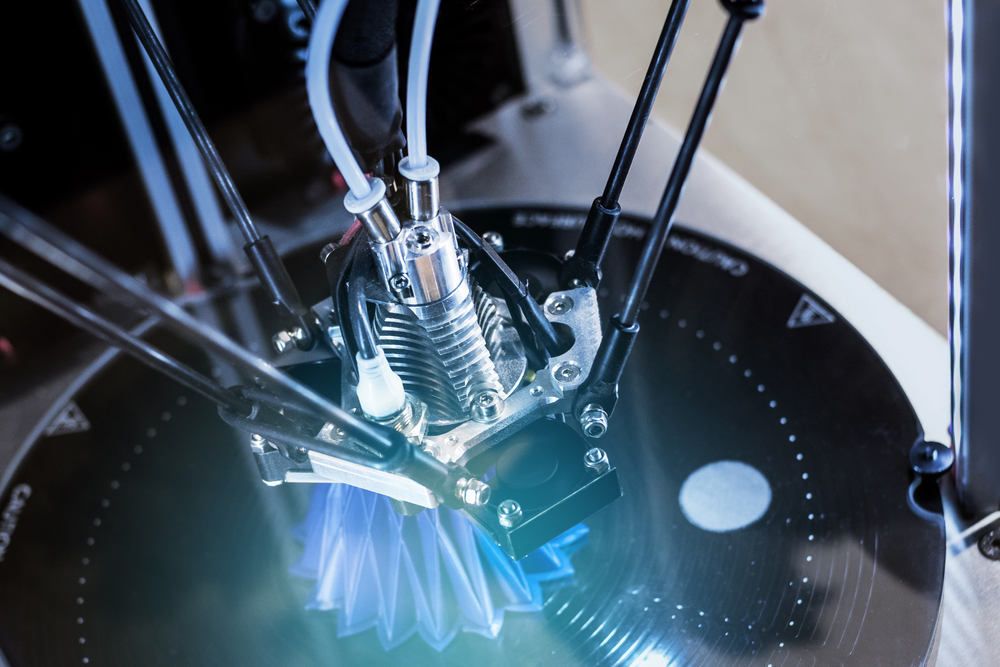Additive manufacturing is the industrial name for 3D printing, both involving fabricating products by adding material, usually in layers. Rapid innovation in additive technology has advanced it from being primarily used for prototyping to manufacturing production-ready parts and altering business models. For companies that are planning to launch new products, reevaluating their production approach with 3D printing technology can provide significant advantages. Additive manufacturing is modernizing manufacturing, bringing new products to market faster, and enabling greater supply chain flexibility.

Common Misconceptions of 3D Printing
3D printing technology has been around for nearly 40 years. However, many companies still do not fully understand the wide range of benefits of 3D printing from prototyping to full production.
For example, many don’t realize that prototypes can go straight into production—no retooling or redesigns are necessary to increase output when there is more demand. Contrast this with a traditional process like injection molding, which often requires significant prototype redesign and new tooling for production or higher volumes. With four decades of advancements, modern additive manufacturing has developed durable, high-quality materials to create products that rival, and even surpasses, those made using traditional methods.
Companies leveraging 3D printing solutions can make higher quality parts at a faster pace than with traditional methods. Additive manufacturing offers several distinct advantages, which easily outweigh the potential disadvantages, as outlined below.
Additive Manufacturing Pros and Cons
| Pros | Cons |
| -Complex geometries -Combining parts to simplify assembly -Eliminate tooling costs -Accelerate products to market -Streamline prototyping to high-volume production -Easier to scale-up | -Cost for end part can be higher than injection molding for high-volume production of the same part |
Pros of Additive Manufacturing
Complex Geometries
Additive manufacturing has no restrictions on the shape of geometric complexity. Because 3D printing can produce any shape in any orientation, designers do not have to compromise on form for manufacturability. A common phrase heard in the additive manufacturing market is “design freedom.”
Reduction of Assemblies
When designers understand the capabilities of 3D printing, they can harness the flexibility to reduce the number of parts in an assembly. Manufacturing a complex manifold assembly using traditional methods may require many parts to get to the final form. A version of the same manifold designed for 3D printing can reduce the assembly down to one part. This concept can apply to many parts and products across industries.
Eliminate Tooling Costs
Traditionally, some of the biggest challenges with initial manufacturing stages are tooling costs. Conventional injection molding techniques require high upfront costs to create the molds necessary for manufacturing and assemble the parts for the final product. These steps involve a great amount of risk, both in the capital investment and large inventory of injection molded products.
3D printing doesn’t use molds. Instead, a digital design guides the 3D printer to create the parts directly, eliminating tooling expenses and unnecessary inventory with traditional manufacturing. Businesses that leverage on-demand 3D printing for production can significantly reduce or eliminate inventory costs and improve capital efficiency and profitability.
Accelerate Products to Market
Eliminating tooling and test runs with new molds also reduces product turnaround time. For instance, even when creating simple parts, injection molding often takes 12-16 weeks to complete the entire process. Factor in potential supply chain issues, and this time can be significantly longer.
Additive manufacturing greatly reduces the production time by providing a one-step printing process. Furthermore, with 3D printing, production can occur anywhere the 3D printing machines are located. Organizations can find or set up convenient Smart Factory locations closer to their markets and customers to reduce logistics costs and complexity as well as accelerate redesign to production cycles. Shortening turnaround time from four months to one to two weeks, allows businesses to introduce products to market more efficiently and reliably.
Streamline Prototyping to High-Volume Production
Molds used for prototyping are not built for high-volume production and sometimes the product needs to be redesigned for high volume production. With modern 3D printers, companies can easily accelerate from initial prototyping to high-volume production on the same machine.
Additive manufacturing’s lower costs, and capability to produce prototypes and production parts without tooling, make it easy to adopt for low-volume production. As product demand increases, companies can then decide to scale with industrial high-throughput 3D printers or a Smart Factory.
Easier to Scale-up
When companies have access to a 3D printer or 3D-printer-enabled smart factory, they can scale instantly and as needed. With traditional manufacturing methods, making different product iterations (e.g., altered materials, colors, sizes, etc.) could take weeks and even months. In contrast, additive manufacturing can produce these models in a market-ready form within a matter of days.
Cons of Additive Manufacturing
Additive manufacturing offers various advantages compared to traditional methods such as injection molding. However, for high-volume production of simple parts, injection molding is often the most economical option.
Many companies invest in steel production molds when producing the exact same single part at high volume. Injection molding is also suitable if the final product does not require a lot of manual overhead or significant transportation costs for assembly.
As industries shift to take advantage of 3D printing technologies, such as in custom or complex products, additive manufacturing will increasingly become the primary choice for manufacturing. Enabling greater design freedom and supply chain optimization for a broad range of industries, additive manufacturing is becoming widely adopted in dental and is making an impact in footwear, medical, and consumer applications.
Additive Manufacturing Pros and Cons: Beyond the Research
Additive manufacturing is reducing production costs, accelerating products to market, and allowing more design freedom and supply chain flexibility. Although conventional manufacturing methods may be the best option economically for certain products, additive manufacturing’s fast-evolving technology and globally distributed Smart Factory production is creating more opportunities for process efficiencies, innovative products, and new business models.
To learn more about additive manufacturing and how it could accelerate your business model, visit our contact page or call (650) 336-0888.
